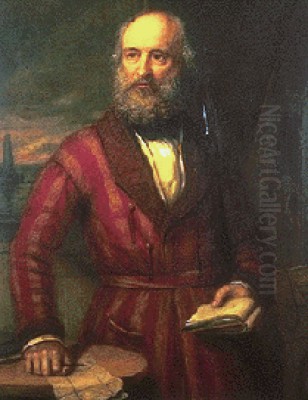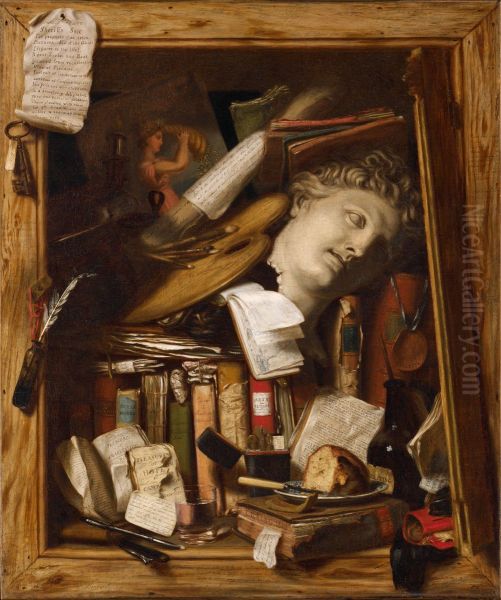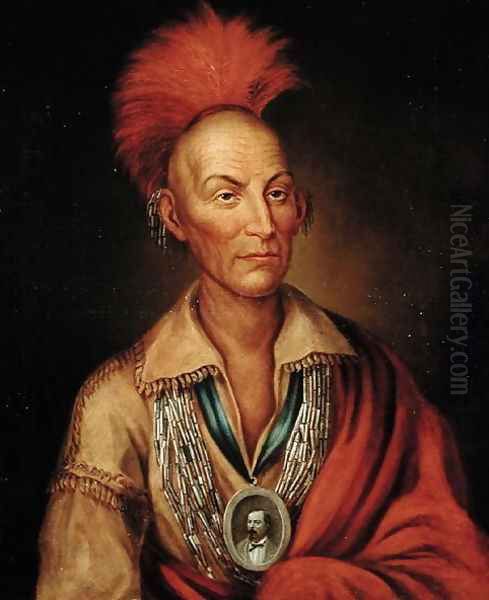
Charles Bird King stands as a significant figure in early American art, primarily celebrated for his compelling portraits that captured the likenesses of prominent political figures and, most notably, Native American delegates visiting the nation's capital. Active during a formative period in the United States, King's career bridged the transition from colonial artistic traditions to a distinctly American sensibility. His work provides invaluable visual documentation of his time, reflecting both the aspirations and the complexities of the young republic. Operating largely in Washington D.C., he became a central artistic figure, documenting the faces that shaped early American policy and society.
Early Life and Artistic Formation
Born in Newport, Rhode Island, in 1785, Charles Bird King was the only child of Captain Zebulon King, a veteran of the Revolutionary War. His early life was marked by tragedy when his father was killed by Native Americans near Marietta, Ohio, in 1796. This event, while deeply personal, adds a layer of complexity to his later extensive work portraying Native American leaders, a project undertaken with apparent respect and diligence. Fortunately, an inheritance provided the young King with the financial means to pursue an artistic education, freeing him from the immediate need to earn a living through other trades.
His formal artistic training began around 1800 in New York City, where he studied under the portrait painter Edward Savage. Savage, known for his portraits of George Washington and his family, provided King with foundational skills in the prevailing style of American portraiture. Seeking more advanced instruction, King followed the path of many ambitious American artists of his generation and traveled to London in 1805. There, he enrolled in the prestigious Royal Academy of Arts, studying under the influential American expatriate painter Benjamin West.

West, then President of the Royal Academy, was a pivotal figure for American artists abroad, offering guidance and access to the London art world. King spent seven years in London (1805-1812), immersing himself in the rigorous academic training offered by the Academy and absorbing the influences of British portraiture and history painting. He shared lodgings for a time with Thomas Sully, another aspiring American painter who would become a lifelong friend and a prominent portraitist in his own right. This period was crucial for honing King's technical skills, refining his draftsmanship, and exposing him to the grand manner of European art, though his own style would ultimately remain more grounded and less idealized than West's historical epics.
Establishing a Career in Washington D.C.
The outbreak of the War of 1812 prompted King's return to the United States. He initially worked itinerantly, seeking commissions in Philadelphia, Baltimore, and Richmond. Philadelphia, then a major artistic center, offered opportunities but also significant competition from established artists like the Peale family – Charles Willson Peale, Rembrandt Peale, and Raphaelle Peale. After several years of establishing his reputation, King made a decisive move in 1818, settling permanently in Washington D.C.
This choice proved astute. The burgeoning capital city, while lacking the established artistic infrastructure of Philadelphia or Boston, was the center of federal power and attracted a steady stream of politicians, diplomats, and influential visitors requiring portraits. King established a studio and gallery on 12th Street, which became a social and cultural hub. He was known for his methodical habits, his business acumen, and his ability to cultivate relationships with the city's elite.
King quickly became the preeminent portrait painter in Washington. His studio was strategically located, and his skills were well-suited to the demands of clients seeking dignified, accurate likenesses. He filled a niche, capturing the faces of the men (and occasionally women) who were shaping the nation's political landscape during the "Era of Good Feelings" and the subsequent Jacksonian period. His success was such that he could afford to be selective about commissions and also pursue his interests in other genres, such as still life.
Portraits of Prominence
During his decades in Washington, Charles Bird King painted many of the most important figures of the era. His sitters included presidents, cabinet members, senators, congressmen, and other dignitaries. Among his most famous subjects were political titans like John Quincy Adams, whose stern intelligence he captured; John C. Calhoun, the influential South Carolina statesman and theorist; Henry Clay, the "Great Compromiser"; Daniel Webster, the famed orator; and President James Monroe.

King's portrait style was characterized by solid draftsmanship, a clear and often direct presentation of the sitter, and careful attention to detail in clothing and accessories, which helped denote the subject's status. While perhaps lacking the painterly flair of his contemporary Gilbert Stuart or the romantic softness of Thomas Sully, King's portraits possessed a reliable clarity and a strong sense of presence. He generally employed a relatively smooth finish and controlled lighting, focusing attention on the face and expression of the sitter.
These portraits served multiple functions. They were personal mementos for families, official records for institutions, and tools for projecting political image and authority. King's ability to consistently produce competent and dignified likenesses made him the go-to artist for Washington's political class. His studio became a place where political figures not only sat for their portraits but also interacted, making it a microcosm of the capital's social and political life. The sheer volume of his output in this area underscores his central role in visually documenting the leadership of the early republic.
The Indian Gallery: A Defining Commission
Undoubtedly, Charles Bird King's most famous and historically significant contribution was his extensive series of Native American portraits. Between 1821 and 1842, he was commissioned by Thomas L. McKenney, the Superintendent of Indian Trade and later head of the Bureau of Indian Affairs, to paint portraits of Native American leaders who traveled to Washington D.C. as part of official delegations to negotiate treaties or discuss tribal matters with the federal government.
McKenney envisioned a national archive, an "Indian Gallery," housed within the War Department (later moved to the Smithsonian Institution), that would preserve the likenesses and cultural attire of prominent figures from various tribes before their cultures were irrevocably altered or extinguished by westward expansion. King became the primary artist for this ambitious project, ultimately producing over 143 portraits (some sources cite slightly different numbers). He painted delegates from numerous tribes, including the Pawnee, Sauk, Fox, Menominee, Winnebago, Iowa, Omaha, Cherokee, Creek, and Choctaw.
King typically painted these portraits from life in his Washington studio. The delegates would often pose in their finest regalia, including feathered headdresses, peace medals presented by the U.S. government, face paint, and traditional garments. King approached these subjects with the same technical proficiency and attention to detail he applied to his portraits of politicians. Works such as the noble depiction of Petalesharo (Generous Chief) of the Pawnee or the poignant portrait of Hayne Hudjihini (Eagle of Delight) of the Otoe tribe exemplify his ability to convey individual character and dignity.
These portraits are complex historical documents. While commissioned by a government pursuing policies often detrimental to Native Americans (including removal), King's paintings generally present their subjects with a sense of gravitas and humanity, avoiding the caricature sometimes found in other depictions of the period. They stand in contrast to the more romanticized, ethnographic field studies of artists like George Catlin, who traveled extensively in the West. King's portraits were studio productions, focused on individual likeness within a formal portrait setting. They became immensely valuable as records of specific individuals and their distinctive cultural attire at a critical juncture in American history.
Artistic Style and Techniques
Charles Bird King's artistic style was rooted in the Anglo-American portrait tradition, shaped by his training under Savage and West. His primary mode was realism, focused on achieving a convincing likeness of his sitter. His drawing was solid, and his compositions were generally straightforward, often employing the standard bust-length or half-length formats popular at the time. He paid close attention to the textures of fabrics and the details of ornamentation, which added to the verisimilitude of his work.
His use of color was typically restrained but effective, with a focus on naturalistic skin tones and careful modeling of form through light and shadow. While influenced by the Neoclassicism prevalent during his training, particularly the emphasis on clarity and structure inherited from Benjamin West, King's work also exhibits elements of the burgeoning Romantic sensibility, especially in the sympathetic portrayal of his Native American subjects, hinting at the "noble savage" archetype popular in the era.
Beyond portraiture, King demonstrated considerable skill in still life painting, a genre less common among leading American artists of his generation, with notable exceptions like Raphaelle Peale and James Peale. King's still lifes often show the influence of 17th-century Dutch masters, particularly in his use of trompe l'oeil (French for "deceive the eye"). This technique involved rendering objects with such meticulous detail and convincing illusion of three-dimensionality that they appeared real, momentarily fooling the viewer.
Beyond Portraiture: Still Life and Genre
While portraiture formed the backbone of his career and income, Charles Bird King also produced a number of intriguing still life and genre paintings. These works often reveal a different side of his artistic personality – one capable of wit, social commentary, and technical virtuosity in the trompe l'oeil style.
His most famous still life is likely The Poor Artist's Cupboard (c. 1815). This painting uses the trompe l'oeil technique to depict the meager contents of an artist's cupboard – a crust of bread, a glass of water, a few books – tacked onto a rough wooden board. It serves as a commentary on the often-precarious financial situation of artists, a theme King understood from his early career. The illusionism is remarkable, inviting the viewer to question the boundary between the painted image and reality.
Another significant work in this vein is The Vanity of the Artist's Dream (1830). This complex allegorical still life presents a jumble of objects – books, prints, a palette, a skull, a newspaper clipping announcing bankruptcy – surrounding a torn print of a painting depicting fame and fortune. It serves as a humorous yet poignant satire on the elusive nature of artistic success and worldly ambition, again likely reflecting on the challenges faced by artists in America. These works connect King to a tradition of moralizing still life that dates back to Dutch Golden Age painting but adapted to an American context. They showcase his technical skill and intellectual engagement beyond straightforward likeness-taking.
Contemporaries and Artistic Milieu
Charles Bird King operated within a dynamic period of American art. He was a contemporary of major figures like Gilbert Stuart, Thomas Sully, Rembrandt Peale, Samuel F.B. Morse (also a painter before focusing on the telegraph), and John Vanderlyn. While based in Washington, he maintained connections with artists in other cities, particularly Philadelphia, through correspondence and exhibitions. He exhibited regularly at the Pennsylvania Academy of the Fine Arts.
His relationship with Benjamin West was foundational, linking him to the Anglo-American academic tradition. His friendship with Thomas Sully provided collegial support. He also played a role as a mentor, most notably to John Gadsby Chapman, who studied with King in Washington before going on to a successful career as a painter and illustrator, known for his large painting The Baptism of Pocahontas in the U.S. Capitol Rotunda.
The artistic environment was competitive, especially for portrait commissions. While King dominated the Washington market for many years, he faced competition from visiting artists and the rising generation. His work on the Indian Gallery also placed him in dialogue, implicitly or explicitly, with other artists depicting Native Americans, such as George Catlin, James Otto Lewis (who also worked for McKenney), and later Seth Eastman. Each artist brought a different perspective and purpose to their depictions, reflecting the complex and often contradictory attitudes towards Native peoples in 19th-century America. King's contribution, focused on formal portraiture of visiting delegates, remains distinct within this group.
The Smithsonian Fire and Legacy
A tragic event profoundly impacted Charles Bird King's legacy. The majority of his original Native American portraits, housed in the Indian Gallery at the Smithsonian Institution, were destroyed in a devastating fire on January 24, 1865. This loss was catastrophic, erasing the primary versions of these invaluable historical and artistic documents.
Fortunately, not all was lost. King himself had painted some replicas of his Native American portraits for his own collection or for other clients. More importantly, Thomas McKenney, anticipating the value of the collection, had commissioned artists, primarily Henry Inman, in the 1830s to create copies of King's portraits before the originals were transferred to the Smithsonian. Inman, a respected portrait and genre painter, produced numerous copies, though he died before completing the entire set.
Furthermore, McKenney collaborated with the writer James Hall to publish the History of the Indian Tribes of North America (1836-1844). This monumental three-volume work featured biographies of the subjects alongside high-quality, hand-colored lithographs based largely on King's portraits (and some by James Otto Lewis). These lithographs, widely disseminated, became the primary means by which King's images of Native American leaders were known to the public and preserved for posterity after the fire destroyed the originals and many of Inman's copies. The McKenney & Hall publication remains a landmark in ethnography and publishing, largely thanks to the power of King's original paintings.
Enduring Influence and Collections
Charles Bird King died in Washington D.C. in 1862 at the age of 77. He never married and, being financially successful, amassed a considerable estate. He bequeathed his personal collection of paintings (including his own works and copies of Old Masters), books, and his fortune to the Redwood Library and Athenaeum in his hometown of Newport, Rhode Island. This generous gift significantly enriched the institution's collection and ensured the preservation of many of his works that might otherwise have been dispersed.
Today, King's paintings are held in major American museums, including the National Portrait Gallery (which holds portraits of political figures), the Smithsonian American Art Museum (which holds some surviving Native American portraits and related works), the White House Collection, the Redwood Library and Athenaeum, and the Crystal Bridges Museum of American Art.
His legacy is multifaceted. As a portraitist, he meticulously documented the key players of early Washington D.C. As the primary artist for the Indian Gallery, he created an unparalleled visual record of Native American leaders during a period of profound cultural encounter and conflict, preserving their likenesses with dignity, even if viewed through the lens of his time. His still life paintings demonstrate technical brilliance and offer insightful commentary on art and society. While perhaps overshadowed in art historical narratives by contemporaries with more flamboyant styles or dramatic lives, Charles Bird King remains a crucial figure for understanding the art, history, and culture of the early American republic. His work continues to be studied for its artistic merit, its historical significance, and the complex cultural encounters it represents. His influence can be seen in the continuation of portraiture in Washington by later artists like Eliphalet Frazer Andrews, and his Native American portraits remain vital resources for historians and tribal communities alike.